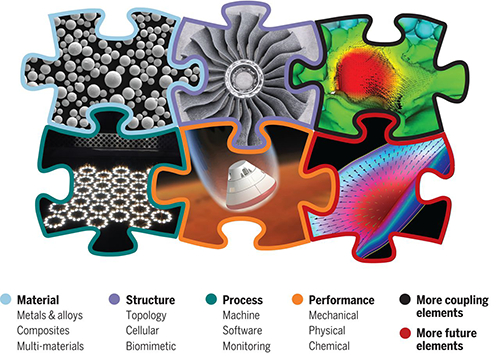Supported by the National Natural Science Foundation of China (Grant Numbers: 51735005, 51921003, 51790171), Prof. Dongdong Gu from Nanjing University of Aeronautics and Astronautics, together with scholars from China, Germany, the United States and the United Kingdom, has made important progress in the research fields of material-structure-performance integrated additive manufacturing. The related research review paper, entitled “Material-structure-performance integrated laser-metal additive manufacturing”, was published in Science on May 28, 2021. The link to the paper is: http://science.sciencemag.org/content/372/6545/eabg1487.
The domain-by-domain localized forming characteristics of laser additive manufacturing determine that the laser forming process and performance involve at least six orders of magnitude cross-scale coordination from microstructure of materials (nanometer- to micrometer-scale) to macro-scale structure and performance of components (millimeter- to meter-scale), which is the key scientific challenge for laser additive manufacturing. The traditional laser-metal additive manufacturing follows a typical “series approach”, i.e., structural design – material selection – processing technology – performance realization. However, due to the complexity in the coupling of material, structure and process, the precision forming of laser additive manufacturing needs repeated trial and error, making it difficult to achieve the high-performance goals of laser printed metal components. To cope with the above challenges, this research team proposed a holistic concept of material-structure-performance integrated additive manufacturing (MSPI-AM), developing a new “parallel mode” with the integration of material, structure, process and performance (Figure 1). The multi-material design and layout and the hierarchical structure innovation and printing can be realized simultaneously in the complex integral component, with an aim to proactively achieve the designed high-performance and multifunctionality.
Driven by the development trends of the integrated design and manufacturing and multi-functionality of the next-generation planetary exploration lander, this research team defined two characteristics and connotations of MSPI-AM, i.e., “the right materials printed in the right positions” and “unique structures printed for unique functions”. The cross-scale realization principles and coordination mechanisms of MSPI-AM were established, including micro-scale material microstructure and interface control, meso-scale process control of powder laser melting and densification, and macro-scale precise coordination of component structure and performance.
The Editor-in-chief of Science made a highlight comment on this research with the title of “Cross-scale coordination”, remarking that “Laser-based additive manufacturing has the potential to revolutionize how components are designed. Gu et al. suggest moving away from a strategy that designs and builds components in a serial manner for a more wholistic method of optimization for metal parts. A more integrated approach will help to reduce the number of steps required for fabrication and expand the types of structures available for end-use components.”

Figure1 Concept and connotation of material-structure-performance integrated additive manufacturing (MSPI-AM)

Add: 83 Shuangqing Rd., Haidian District, Beijing, China
Postcode: 100085
Tel: 86-10-62327001
Fax: 86-10-62327004
E-mail: bic@donnasnhdiary.org
京ICP备05002826号 文保网安备1101080035号 Copyright 2017 NSFC, All Right Reserved